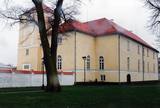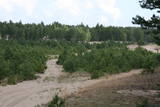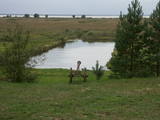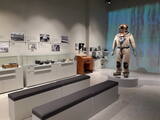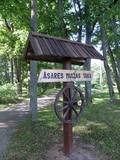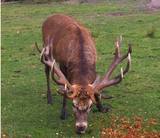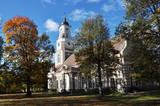| Нo | Название | Описание |
|---|---|---|
|
Замок возводился как военный стратегический объект, поэтому за время своего существования пережил разные власти и времена. Строение (впервые упомянуто в конце 13 века), невзирая на опустошительные войны, с небольшими изменениями сохранило свой основной объем и сущность замка Ордена, что является уникальным для Латвии случаем! Считается старейшим замком средневековья в Латвии. С 2001 года в здании располагается Вентспилсский музей - один из современнейших в Латвии. |
||
|
На огромной площади по обоим берегам реки Ирбе расположено насколько территорий, соединяющихся танковыми дорогами. В свое время здесь проводись танковые тренировочные заезды и испытания. В настоящее время площади не используются и понемногу зарастают лесом.
|
||
|
Along with the Nagļu ponds, these are Latvia’s largest fishing ponds. They were established on the flood-land peat areas of Lake Lubāns in the 1970s, when the hydrotechnical system of the lake was first established. The Lubāna-Gaigalava road bisects the Kvāpāni-Īdeņa ponds. There are three bird-watching towers on the dams of the ponds. The ponds are a major location for water bird nests, as well as places for migrating birds to rest. There are extensive bird-watching opportunities in the area.
|
||
|
A panoramic tour of Lithuania and Latvia with highlights of nature experiences in the National parks and nature reserves. A variety of landscapes, nature attraction sites, birds and wild animals, forests and seashore. The tour also offers some cultural and historical insights. Baltic States are lucky to have plenty of untouched natural territories. During the Cambrian, Silurian and Devonian eras, the territory of the current Baltic States was often covered by seawater, which is why there are places where lots of geological evidence can be found about these periods in history. These are manifested not just in fossils and various geological objects, but also in the unique landscape. For example, The Gauja River basin is an outstanding locations for Devonian cliffs and caves. Other interesting elements of the terrain relate to the development of the Baltic Sea in the past – the Baltic Ice Sea and the Littorine Sea. That is well presented at he landscape of hillocks and valleys in the Slītere National Park. Many forests and bogs have remained virtually untouched as biotopes here. The Ķemeri, Slītere national parks were all established to protect wetlands. Rivers in the Baltic States have not been straightened and dense areas of buildings are not common. There are two “lands of lakes” in the Baltic States – Latgale and Augštaitija. The Baltic States are at the crossroads of the living areas of many different plants and animals, and that is why “northern,” “southern,” “western” and “eastern” species can all be found here. Some national parks have been established to protect distinctive local cultural heritage. |
||
|
Zirgi un citi lauku iemītnieki. Dažāda veida izklaides ar zirgiem gan saimniecībā, gan ārpus tās, un saimniecībā mitošo iemītnieku apskate. |
||
|
This exhibition features the Pļaviņas hydroelectric power plant as a unique architectural building with unique engineering elements. It is the largest producer of electricity in the Baltic States and one of the largest in
|
||
|
Статуя святой Марии, в народе называемая „статуя Мадонны”,
после восстановления в 1991 году повторно установлена в парке
господской усадьбы Лузнава.
|
||
|
Asares muižas romantiskā stila dendroloģiskais ainavu parks veidots 18. gs. un papildināts 19. gs. 2. pusē. Muižas parka teritoriju ieskauj laukakmeņu mūris. Bet parkā sastopamas daudz interesantas krūmu un koku sugas: Sibīrijas baltegles, Eiropas lapegles, duglāzijas, šķeltlapainie baltalkšņi, Švedlera kļavas, košumkrūmi, dažādi lakstaugi. Liepu alejā - 2 dižkoki. Tempļa kalna atjaunotajā lapenē - muižnieku tējas dzeršanas vieta ar skatu uz pili. |
||
|
Трактир, расположившийся в деревянном срубе, стоящем на въезде в Сигулду, позволяет прочувствовать латышский дух в интерьере и насладиться едой в латышском стиле. В трактире бережно сохраняются традиции и качество приготовления блюд латышской кухни. Латышская кухня: Суп из кислой капусты, филе судака, котлеты из щуки, свиной язык, свиные ребрышки, домашние котлеты, картофельные блины, слойка из черного хлеба, в меде печеный черный хлеб, печеное яблоко, домашнее мороженое. Особое блюдо: «Стейк от Буцефала», «Мороженое от Буцефала». |
||
|
The Ludza castle hill offers one of the most interesting views in Latgale – that of the oldest town in Latvia and its historical centre, Great Lake Ludza and Small Lake Ludza, the ruins of the castle of the Livonian Order, Baznīckalns hill, churches, the regional research museum, the craftsmen’s centre, etc.
|
||
|
Baltijā lielākās HES celtniecību uzsāka 1961. g., bet pabeidza 1966. g. Tajā uzstādīto 10 hidroagregātu projektētā jauda bija 825 MW. Pļaviņu HES tiek uzskatīta par unikālu, jo pirmoreiz HES būvniecības praksē tā konstrukcija tika balstīta uz mālsmilts un smilšmālu gruntīm ar maksimālo spiedienaugstumu - 40 m! Pļaviņu HES ēka ir apvienota ar ūdens pārgāzi, zem kuras atrodas Latvijas garākais tunelis - Enerģētiķu iela. 20. gs. deviņdesmitajos gados Pļaviņu HES rekonstruēja un tagad tās jauda ir sasniegusi 870 MW. Apmeklētāji var iepazīt mašīnzāli, skatu laukumus un HES maketu. |
||
|
Находится на кладбище Бертуля. Создан по проекту Л. Швалбе. На лицевой стороне памятника помещена бронзовая плита с надписью «С глубокой благодарностью за Латвию павшим народным героям. 10-ое Руйиенское отделение Даугавас ванаги». На тыльной стороне памятника находится надпись «Бог, Отечество, Народ». Памятник был восстановлен в 1989-м году. |
||
|
Тропа длиной 2 км была создана в 1994 г. От автостоянки она вьется на берег долины Даугавы, где в окружении леса спряталось одно из самых маленьких латгальских городищ. Южную часть городища выкопали в 20-х годах 20 века, когда здесь добывали гравий. Площадка городища находится на высоте ~ 40 м над уровнем Даугавы, поэтому через небольшое смотровое отверстие открывается впечатляющий вид на долину реки. На обочине тропы недалеко от ручья Путану установлен столб, на котором обозначена максимальная отметка уровня воды на проектированной в то время Даугавпилсской ГЭС. В дальнейшем тропа ведет к деревне Слутишки. |
||
|
Во вторую субботу каждого месяца (по предварительной договоренности и в другое время) в присутствии хозяина каждый сам может применить свои навыки в копчении рыбы, после чего следует дегустация приготовленной рыбы. |
||
|
Skuķu un netāli esošais Dvietes ezeri ir vieni no teritorijas grūti pieejamajiem palieņu ezeriem – lielākie šāda tipa
ezeri Latvijā. Palu laikā pārplūst, savienojoties vienā lielā ūdenskrātuvē.
|
||
|
В очень красивом месте (с видом на озеро Саукас) хозяин выращивает крупный рогатый мясной скот, который на протяжении всего года пасется на склонах окрестных холмов. Он проведет экскурсию, покажет коров и предложит сладкие вишни и яблоки из своего сада. |
||
|
В хозяйстве выращивают коноплю и предлагают познакомиться с историей этого растения, его использованием в рационе и в бане. Здесь производят конопляное масло и молоко. Экскурсия, приобретение произведенной продукции. |
||
|
he wetland meadows that are around the Pededze River are the site of this 200 ha farm with some 350 red deer, other deer and wild boar. There are towers from which you can watch the graceful animals, and there are ponds for commercial fishing. Please contact the owner well in advance for a tour. |
||
|
After the death of the Kalnasikšņi oak tree, which was the mightiest tree in the Gauja National Park, the mighty Kvēpene oak tree has taken over that role. It has a circumference of 6.1 m, a height of 20 m, and a crown which measures 28 x 30 m. The beautiful tree is on the right bank of the Gauja River valley and is one of the most excellent trees in Latvia. Near it is the forested Kvēpene castle hill, as is the Svētavots stream, which is reputed to have medicinal waters. To the North of the castle hill is the Rūsiņš hillock, which offers a good view of the surrounding forests, the towers of the city of Cēsis, Ieriķi, and the Rakšupe estuary at the Gauja. There is a bench at the top of the hillock from which lovely sunsets can be seen. |
||
|
Церковь была построена во времена барона Отто Германа фон Фитингофа с 1781-й по 1788-й годы по проекту архитектора К. Хаберланда в стиле классицизма с чертами барокко и цветной мозаикой из каменной крошки на фасаде здания. Орган церкви в 1855-м году изготовил Аугустс Мартинс. Церковный колокол во время Первой мировой войны был вывезен в Россию и на его место был установлен другой, отлитый в 1530-м году. Алтарная картина (автор неизвестен) «Крещение Христа» была восстановлена в 2000-м году. В середине 19-го в Алуксненском приходе было много эстонцев, поэтому богослужения проходили и на эстонском языке. Восстановительные работы были проведены в 1934-м году под руководством архитектора П. Кампе. Теперь фундаментальное здание с башней высотой 55,5 м является одной из доминант города. |
||
